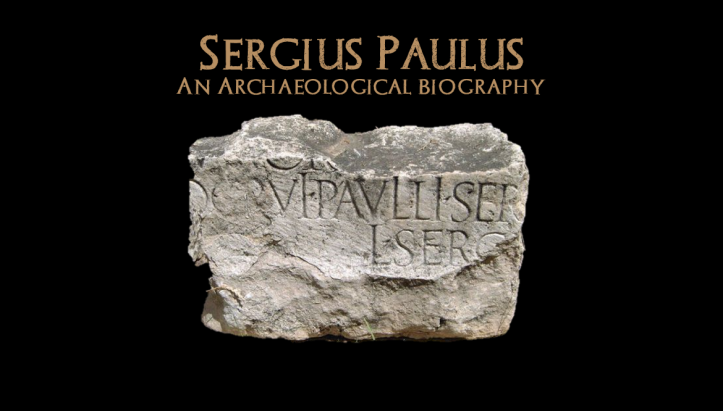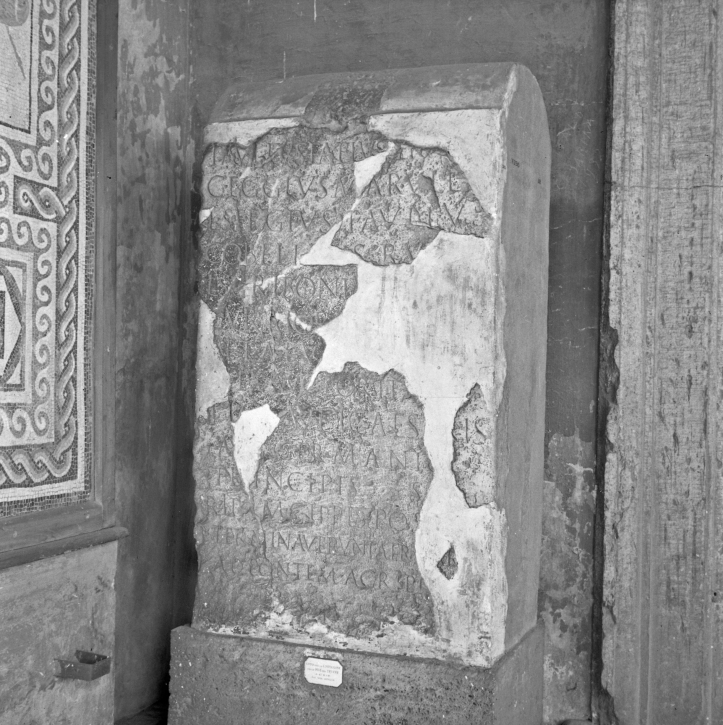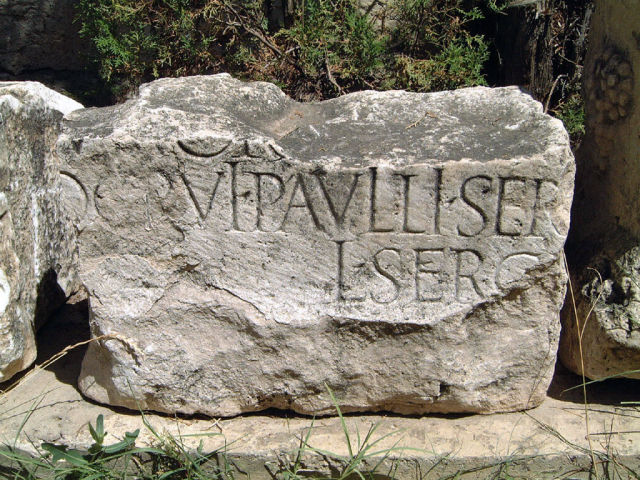
In our series of bioarchaeographies, we’ve been using archaeology to tell the life story of biblical figures. So far we’ve studied King Hezekiah, Pontius Pilate, Nebuchadnezzar, Gallio, and Tiglath-Pileser III. With each of these biblical characters, we’ve seen direct archaeological evidence that affirms their historicity as well as specific details in Scripture. Sometimes in archaeology, however, a possible reference to a certain person is found, rather than a clear, unequivocal reference. This necessitates a “connect-the-dots” type of approach, as archaeologists seek to interpret the inscriptions that are discovered. Such is the case with the subject of this archaeological biography: Sergius Paulus.
Paul and Barnabas met the proconsul, Sergius Paulus, during a missionary trip to Cyprus. In Act 13:6-7, we read, “When they had gone through the whole island as far as Paphos, they came upon a certain magician, a Jewish false prophet named Bar-Jesus. He was with the proconsul, Sergius Paulus, a man of intelligence, who summoned Barnabas and Saul and sought to hear the word of God.” Sergius Paulus eventually put his faith in Jesus Christ (Acts 13:12) and, after leaving Cyprus, Paul and Barnabas made their way to Pisidian Antioch (Acts 13:14).
Proconsuls were important men in the Roman Empire during the first century. Is there evidence of a prominent man named Sergius Paulus around this time (AD 45-50) who we might identify as the proconsul of Cyprus? Indeed, there is: multiple inscriptions naming a certain “Sergius Paulus” indicate that such a man was an official in the Roman empire in the middle of the first century.
Roman Names
To begin, we need to understand Roman names. Typically, Roman men had three names: a praenomen (informal “first name”), nomen (gens or clan name), and cognomen (small family name).1 Gaius Julias Caesar is a good example. With Sergius Paulus, only his nomen and cognomen are given in Acts 13, not his praenomen/first name. Still, as we shall see, a number of inscriptions bear this name, and even a first initial.
Inscriptions

In 1877 a Greek inscription was discovered at Soloi, on the northern coast of Cyprus, which mentions a proconsul named Paulus. This inscription (IGR III, 930), which has been dated to the middle of the first century, is currently housed in the Cyprus museum and reads:
“Apollonius to his father…consecrated this enclosure and monument according to his family’s wishes…having filled the offices of clerk of the market, prefect, town-clerk, high priest, and having been in charge as manager of the records office. Erected on the 25th of the month Demarchexusius in the thirteenth year [of the reign of Claudius – 54 AD]. He also altered the senate by means of assessors during the time of proconsul Paulus.”2
Note that, while the inscription dates to 54 AD, it references an event earlier than this, during the time of the proconsul Paulus. This inscription establishes that someone in the Pauli family was proconsul on the island of Cyprus around the time the Bible describes Sergius Paulus in such a role. D. G. Hogarth personally inspected the inscription in 1888 and wrote, “The great interest of this inscription lies in the possible allusion to the Sergius Paulus of Acts xiii. There can be no good reason for doubting an identification, which would unquestionably have been proposed and hardly disputed had Sergius Paulus been known from any other source than the New Testament.”3

Another inscription on a boundary stone from Rome names L. Sergius Paullus as one of the curators of the Tiber River (Note: Paullus is the Latin spelling; Paulus is the Greek spelling) . It has been dated to 47 AD. Due to the very limited number of first names commonly used among men in Rome, it is probable that L. stands for Lucius. The inscription (CIL 6.31545) reads:
“Paullus Fabius Persicus
Gaius Eggius Marullus
Lucius Sergius Paullus
Gaius Obellius Rufus
Lucius Scribonius Libo (?)
The commissioners of the banks and beds of the Tiber, by the authority of Tiberius Claudius Caesar Augustus Germanicus [the emperor Claudius], leader of the Senate (?), marked the boundaries [of the Tiber floodplain] by placing boundary stones on the bank from the Trigarium to the Pons Agrippae.”4
Thus, a man named Lucius Sergius Paulus held a position as a Roman official overseeing the Tiber River in the middle of the first century. As commissioner of the banks and beds of the Tiber, he would have been “responsible for managing the flow of the river to prevent the disastrous flooding that sometimes occurred in the city.”5 New Testament scholar, Ben Witherington III, concludes: “The fact that the Latin inscription, datable to the 40’s, like the text of Acts 13, mentions a prominent Sergius Paulus as a public figure suggests a connection between the two since clearly Paul’s visit to Cyprus must also be dated to the reign of Claudius in the later 40’s. This would provide one more piece of evidence, though indirect, that Luke is dealing with historical data and situations, not just creating a narrative with historical verisimilitude.”6 It is quite possible that Lucius Sergius Paulus served as commissioner of the Tiber River either before or after becoming the proconsul of Cyprus. While some have suggested that Sergius Paulus was demoted from his role as procurator of Cyprus after he put his faith in Christ, the dating of the inscriptions is not precise enough to pinpoint the order in which he served in each role.

Two more Sergius Paulus inscriptions have been discovered near Pisidian Antioch. The most famous is currently housed at the Yalvac Museum. On it, the whole family name Paulii and part of the name Sergii are clearly visible.7 Though fragmentary, it has been reconstructed to read, “L. Sergius Paulus.” Unfortunately, no title or position is given for this individual. Another inscription was copied by Sir William Ramsay and J.G.C. Anderson near Pisidian Antioch in 1912. It reads, “To L(ucius) Sergius Paullus, the younger, son of Lucius, one of the four commissioners in charge of the Roman streets, tribune of the soldiers of the sixth legion styled Ferrata, quaestor…”8 Ramsay identifies this L. Sergius Paullus (the younger) as the son of L. Sergius Paullus who was the proconsul of Cyprus. He also discovered another inscription referring to a lady named Sergia Paula, whom he identifies as the daughter of L. Sergius Paullus, the proconsul of Cyprus. It should be noted that Ramsay bases his identification on his speculation of the dates of the inscriptions and the possible ages of each individual, and should be viewed as just that – a hypothesis.

Still, the number of inscriptions referring to the Sergius Paulus family around Pisidian Antioch have led some scholars to suggest that the family estate was nearby, which raises an interesting possibility given that the Apostle Paul and Barnabas made their way to this city immediately after they left Cyprus. Dr. Titus Kennedy summarizes, “ It is possible, though unconfirmed and only a hypothesis based on circumstantial evidence, that the reason Paul and Barnabus traveled to Antioch after Cyprus is because Sergius Paulus had family ties there. If so, the L. Sergius Paulus mentioned on the stone inscription from Antioch may further illuminate the life of the proconsul Sergius Paulus who held positions on Cyprus and in Rome.”9 Some speculate that Sergius Paulus adopted Saul into the Paulus family through the common Roman practice of adult adoption known as adrogation. This, they propose, explains why Saul is henceforth known as Paul immediately after this account in the book of Acts, and how he may have gone to Antioch to be introduced to the family. It’s an interesting hypothesis.
One final inscription from Kytharia, Cyprus has been suggested as relating to the proconsul Sergius Paulus. It bears the name “Quintus Ser[gius]” and, while the name of the emperor is lost, it can be restored as either Tiberius (14–37 AD), Caligula (37–41 AD), or Claudius (41–54 AD).10 If it is Claudius, it would be further evidence of the Sergius clan on Cyprus at the time the Bible describes; if it is Tiberius or Caligula, it would be too early to make a connection. Furthermore, given the fragmentary nature of the inscription, it is not possible to conclusively state what the nomen and cognomen should be. While some have suggested Quintus Sergius Paulus, this is tentative at best.

Literary References
In his work, Natural History, Pliny the Elder lists a number of authors whom he used as sources for some of his material. Among these is Sergius Paulus, who appears to have also been an author on Natural History in his own right, although his work has been lost. Interestingly, in his second and 18th book, Pliny writes about Cyprus, and makes note of its magicians. Bill Cooper suggests, “To be quoted and relied upon by Pliny as an authority, your scholarly credentials had to be second to none, and Sergius Paulus was clearly highly esteemed as an author on Natural History for Pliny to rely on his work as he did. Against this background, Luke’s statement concerning Sergius Paulus – that he was a “prudent man” [a man of intelligence – ESV] (Acts 13:7) – takes on added meaning.”11
Summary
Based on the inscriptional evidence, many scholars have concluded that there was indeed a prominent Roman official named Sergius Paulus in the middle of the first century. It appears that his full name was Lucius Sergius Paulus, and that, in addition to serving in various roles in the Roman empire, he was also a respected author. Ben Witherington III concludes: “In sum, the inscriptional evidence clearly places Sergii Pauli on the island of Cyprus and the Latin inscription about Lucius of that family may point us to the man in question. Given what we know about the Roman career patterns of the time it is quite feasible that a curator of the Tiber might have before or after his curatorship served as proconsul on Cyprus.”12 By connecting the dots, it is reasonable to interpret the evidence as suggesting that Lucius Sergius Paulus was likely the proconsul of Cyprus whom Paul met and led to faith in Christ Jesus.
Title Photo of Sergius Paulus Inscription from Pisidian Antioch: HolyLandPhotos.org
Endnotes:
1 Latintutorial. “Roman Names.” YouTube video, 2:07. Posted Aug. 11, 2011. https://www.youtube.com/watch?v=5zrfAzTtGdc
2 Joseph M. Holden and Norman Geisler, The Popular Handbook of Archaeology and the Bible, (Eugene: Harvest House Publisher, 2013), 352.
3 D. G. Hogarth, Devia Cypia. (London: Oxford, 1889), 115. Online: https://archive.org/details/deviacyprianotes00hoga/page/114 (Accessed Nov. 7, 2019).
4 This translation was provided by Wendy Watkins, the curator of the Center for Epigraphical and Palaeographical Studies, The Ohio State University, by personal email on Nov. 5, 2019.
5 Clinton E. Arnold, Acts. Zondervan Illustrated Bible Background Commentary. (Grand Rapids: Zondervan, 2002). Online: https://books.google.ca/books?id=9oqGCwAAQBAJ&pg=PT238&lpg=PT238&dq=Clinton+E.+Arnold+Acts+Sergius+Paulus&source=bl&ots=K8ItmOGKN2&sig=ACfU3U1tcIS16s3HnbangQfF310SaFpd2w&hl=en&sa=X&ved=2ahUKEwjk2IL6w9XlAhUJmuAKHaXRBWUQ6AEwAXoECAkQAQ#v=onepage&q=Sergius%20Paulus&f=false (Accessed Nov. 5, 2019).
6 Ben Witherington III, The Acts of the Apostles: A Socio-Rhetorical Commentary. (Grand Rapids: William B. Eerdmans Publishing Company, 1998), 400. Online: https://books.google.ca/books?redir_esc=y&id=2P7zSnM9BjMC&q=sergius+Paulus#v=snippet&q=sergius%20Paulus&f=false (Accessed Nov. 4, 2019).
7 Rob Sullivan, “Cypriots, Sorcerers, and Sergius,” Associates for Biblical Research. May 31, 2016. https://biblearchaeology.org/research/new-testament-era/3902-cypriots-sorcerers-and-sergius (Accessed Nov. 4, 2019).
8 W.M. Ramsay, The Bearing of Recent Discovery on the Trustworthiness of the New Testament, (London: Hodder and Stoughton, 1915), 151.
9 Titus Kennedy, “Sergius Paulus the Proconsul and the Apostle Paul,” APXAIOC. 11/12/2014. https://apxaioc.com/article/sergius-paulus-proconsul-and-apostle-paul (Accessed Nov. 4, 2019).
10 “Marble Inscribed Block Fragment,” The Metropolitan Museum of Art. https://www.metmuseum.org/art/collection/search/241979 (Nov. 5, 2019).
11 Bill Cooper, “Who Was Sergius Paulus?” Bible and Spade. Vol. 29, No. 3 (Fall 2016), 96.
12 Ben Witherington III, The Acts of the Apostles: A Socio-Rhetorical Commentary. (Grand Rapids: William B. Eerdmans Publishing Company, 1998), 400. Online: https://books.google.ca/books?redir_esc=y&id=2P7zSnM9BjMC&q=sergius+Paulus#v=snippet&q=sergius%20Paulus&f=false (Accessed Nov. 4, 2019).

Great research and connecting of the dots
[…] up the results of archaeological research on Sergius Paulus, the proconsul mentioned in Acts 13 (here), and on Tiglath-Pileser III, the king of Assyria mentioned in 2 Kings 15 […]
[…] https://biblearchaeologyreport.com/2019/11/15/sergius-paulus-an-archaeological-biography/ […]
[…] like Caesar Augustus, Quirinius, Herod Agrippa I and II, Herod Antipas, Pontius Pilate, Gallio, and Sergius Paulus. In this article, we’ll explore the life of one of the most notoriously wicked kings of Israel: […]
[…] Sergius Paulus, https://biblearchaeologyreport.com/2019/11/15/sergius-paulus-an-archaeological-biography/ This really interesting article also raises the possibility that Sergius Paulus adopted Paul and […]